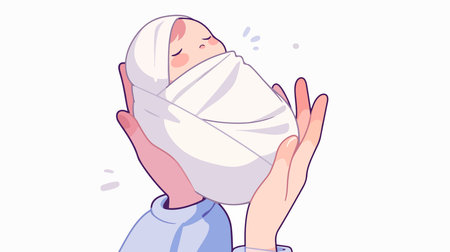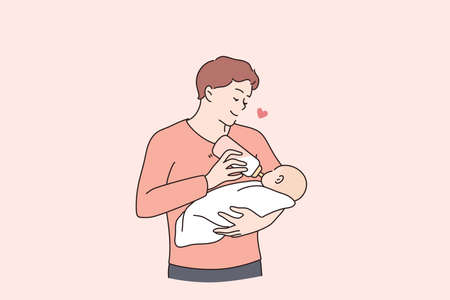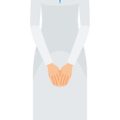Understanding Nappy Rash
Nappy rash, also known as diaper rash, is a common skin irritation that affects many infants in the UK. It typically presents as red, inflamed patches on the baby’s bottom, genitals, or upper thighs. The primary cause of nappy rash is prolonged exposure to moisture, urine, and faeces, which can irritate delicate skin. Additional factors such as infrequent nappy changes, use of certain soaps or wipes, and even the introduction of new foods can contribute to the development of this condition. In some cases, a fungal or bacterial infection may complicate the rash. According to NHS data, most babies will experience nappy rash at some point during their early years, particularly between the ages of 9 and 12 months when they spend longer periods wearing nappies and begin dietary transitions. Understanding the causes and prevalence of nappy rash is crucial for UK parents aiming to prevent and manage this uncomfortable but usually mild condition effectively.
2. Recognising the Early Signs
For UK parents, spotting the early signs of nappy rash is vital in preventing discomfort and potential complications for your baby. Nappy rash typically presents as redness, inflammation, or small spots on areas covered by the nappy. However, it is important to distinguish these symptoms from other skin conditions such as eczema or thrush, which may require different approaches. Early intervention, supported by NHS guidance, ensures that minor irritations do not escalate.
Common Symptoms of Nappy Rash
| Symptom | Description | Possible Cause |
|---|---|---|
| Red Patches | Redness mainly on the buttocks, thighs, and genitals | Prolonged contact with urine or faeces |
| Mild Swelling | Slight puffiness in affected areas | Skin irritation from moisture or friction |
| Small Spots or Blisters | Tiny red spots or raised bumps | Bacterial or fungal overgrowth due to dampness |
| Irritability During Changes | Crying or discomfort when changing nappies | Pain caused by inflamed skin |
Distinguishing Nappy Rash from Other Skin Conditions
Nappy rash usually improves with regular airing and barrier creams. If you notice persistent redness spreading beyond the nappy area, shiny patches, satellite spots (small patches away from the main area), or white spots, these could indicate a fungal infection (such as candida) or another dermatological issue like eczema. Consult your GP or health visitor if symptoms persist for more than a few days or worsen despite standard care.
Key Differences Table: Nappy Rash vs. Other Conditions
| Condition | Main Features | NHS Advice |
|---|---|---|
| Nappy Rash | Redness limited to nappy area; responds to barrier creams and frequent changes; no systemic symptoms | Monitor at home; use recommended creams; seek help if no improvement in 3 days |
| Candida Infection (Thrush) | Persistent redness with defined edges; satellite lesions; may not respond to usual treatment; sometimes white patches present | Consult GP for antifungal cream prescription; maintain hygiene and dryness |
| Eczema/Other Dermatitis | Dry, flaky skin possibly affecting areas outside the nappy zone; family history common; may be itchy rather than sore from contact alone | Seek advice from health visitor or GP for tailored skincare guidance and possible medicated creams |
When to Seek Medical Advice?
If your baby develops a fever, blisters, pus-filled sores, or if the rash spreads rapidly beyond the nappy area, seek prompt medical attention as these could be signs of a more serious infection. The NHS recommends not using over-the-counter steroid creams without professional advice. Early recognition allows parents to provide appropriate care and prevent escalation.

3. Daily Prevention Strategies
Preventing nappy rash is often easier than treating it, and a consistent daily routine can make all the difference. The NHS recommends changing your baby’s nappy frequently—ideally as soon as it becomes wet or soiled—to limit prolonged contact with moisture and irritants. This is especially important for newborns and younger infants who may require more frequent changes.
When changing nappies, use plain, lukewarm water and soft cotton wool or fragrance-free wipes to gently cleanse the area. Avoid rubbing, which can aggravate sensitive skin. After cleaning, ensure the skin is completely dry before putting on a fresh nappy. Allowing your baby some nappy-free time each day can also help keep the skin healthy by letting it breathe.
Choose nappies that are highly absorbent and fit well without being too tight, as excessive friction or dampness increases the risk of rash. If you use reusable cloth nappies, rinse them thoroughly to remove detergent residues that might irritate the skin. Consider applying a thin layer of a barrier cream—such as one containing zinc oxide or petroleum jelly—as part of your regular routine, especially if your baby is prone to rashes.
Finally, dress your baby in loose-fitting clothing made from breathable fabrics like cotton to minimise heat and moisture build-up. These simple steps, endorsed by the NHS, form the foundation of effective daily care to reduce the risk of nappy rash for babies across the UK.
4. Treatment Options at Home
When dealing with nappy rash, prompt and appropriate home care can make a significant difference in your babys comfort and recovery. Below, we outline safe and effective treatment methods recommended by the NHS and widely adopted across the UK.
Creams and Ointments Available in UK Pharmacies
Barrier creams and ointments are essential for protecting delicate skin from moisture and irritants. Many of these products are readily available at local chemists such as Boots, LloydsPharmacy, or even larger supermarkets. Here’s a quick comparison:
| Product Type | Examples | Main Ingredients | Typical Use |
|---|---|---|---|
| Barrier Creams | Sudocrem, Bepanthen, Metanium | Zinc oxide, dexpanthenol, titanium dioxide | Apply thinly after each nappy change to protect skin |
| Emollient Ointments | Epaderm, Doublebase Gel | Paraffin-based emollients | Soothe and moisturise dry or irritated skin |
| Mild Hydrocortisone (by GP prescription only) | Various brands | Low-dose hydrocortisone 1% | Short-term use for severe cases under medical advice |
Air Time: Letting Skin Breathe
The NHS recommends giving your baby regular periods without a nappy to allow air to circulate around the affected area. This helps the rash heal faster by keeping the skin dry and reducing further irritation. Lay your baby on a soft towel or waterproof mat during these intervals, ensuring they are warm and supervised at all times.
Gentle Cleansing Practices
Cleansing the nappy area gently is crucial. Use lukewarm water and soft cotton wool or fragrance-free wipes specifically designed for sensitive skin. Avoid soaps, bubble baths, or wipes containing alcohol or fragrances, as these can aggravate the rash further. Pat the area dry with a soft towel—never rub.
Summary of Effective Home Treatments
- Frequent Nappy Changes: Change nappies promptly after soiling to minimise contact with urine and faeces.
- Use Suitable Barrier Creams: Apply a thin layer during each change as per product instructions.
- Avoid Irritants: Steer clear of perfumed products and harsh cleansers.
- Encourage Air Exposure: Give regular nappy-free time daily.
- Monitor Progress: If there is no improvement after a few days or if symptoms worsen, consult your GP or health visitor for further advice.
5. When to Seek Medical Advice
Nappy rash is common and often manageable at home, but it is important for UK parents to know when professional medical advice is needed. The NHS provides clear guidelines to help you recognise signs that warrant a visit to your GP or health visitor.
Recognising When Nappy Rash Needs Professional Attention
While most mild cases improve with good nappy care and barrier creams, you should seek medical advice if:
- The rash persists for more than seven days despite recommended treatment.
- The rash worsens, spreads, or becomes intensely red and inflamed.
- Your baby develops blisters, yellowish patches (which may indicate infection), or open sores.
- Your child appears unwell, has a fever, or the rash is accompanied by other symptoms such as vomiting or diarrhoea.
- You notice signs of thrush (bright red rash with defined edges and white spots in skin folds) or the skin looks shiny.
Accessing NHS Resources
If you are concerned about your babys nappy rash, you can contact your local GP surgery or speak to your health visitor. NHS 111 is also available for non-urgent medical queries and guidance outside of normal surgery hours. For further information, the NHS website provides comprehensive advice on prevention, management, and when to seek help. Do not hesitate to seek support if you feel unsure—prompt attention ensures your babys comfort and wellbeing.
6. Myth-Busting and FAQs
Addressing Common Misconceptions
Nappy rash is a prevalent concern among UK parents, but several myths persist about its causes and management. One widespread misconception is that nappy rash always signals poor hygiene; in reality, even the most attentive parents can face this issue due to a baby’s sensitive skin or naturally occurring irritants in urine and faeces. Another common myth is that cloth nappies prevent all rashes. While breathable fabrics may help reduce irritation for some babies, no nappy type guarantees complete protection—frequent changes and good skincare are essential regardless of the nappy used.
Frequently Asked Questions
Is nappy rash contagious?
No, nappy rash itself is not contagious. However, if a secondary infection develops (such as thrush), it’s important to follow NHS advice on hygiene and treatment to prevent spreading the infection.
Can teething cause nappy rash?
Teething does not directly cause nappy rash, but many parents notice an association. This may be due to changes in stool consistency or frequency during teething periods, which can increase skin irritation.
Should I use talcum powder?
The NHS does not recommend using talcum powder for nappy rash prevention or treatment, as it can irritate your baby’s lungs and may worsen skin problems.
When should I see my GP?
If your baby’s rash does not improve after a few days of home care with barrier creams and regular nappy changes, or if you notice blisters, yellowish fluid, or your child seems unwell, consult your GP or health visitor for further advice.
Key Takeaway for UK Parents
By debunking these myths and relying on NHS-backed guidance, UK parents can confidently address nappy rash with effective, evidence-based solutions tailored to their children’s needs.

